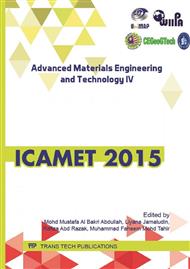p.519
p.524
p.530
p.535
p.540
p.547
p.555
p.560
p.565
Removal of Iron (Fe) in Rice Husk via Citric Acid Leaching Treatment
Abstract:
Rice husk (RH) is an agricultural waste which has been utilized as useful renewable resources to produce energy with high-purity silica (SiO2) contents. With such a large availability of rice husk, it becomes economical to industrial applications. This paper was study about the removal of iron from rice husk in aqueous citric acid by using acid leaching treatment. The parameters chosen were reaction temperature, stirring speed, acid concentration and stirring time. The optimum conditions for the maximum removal of 0.14% of iron with citric acid leaching treatment were observed at solution temperature of 70°C; thermostat magnetic stirrer hotplate, 150 W; acid concentration 0.1M-1.0M; stirring time 6h-12h. This method resulted the removal efficiency of iron increasing considerably with the increasing leach C2H7O8 acid concentration. The optimization of the process conditions of the citric acid leaching treatment under the optimum conditions with 6h of stirring time and acid concentration of 1.0M were conducted to remove the metallic impurities of Fe from husks and shows remarkable result.
Info:
Periodical:
Pages:
540-546
Citation:
Online since:
May 2016
Keywords:
Price:
Сopyright:
© 2016 Trans Tech Publications Ltd. All Rights Reserved
Share:
Citation:


